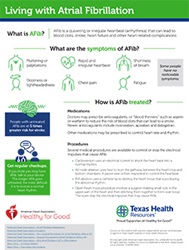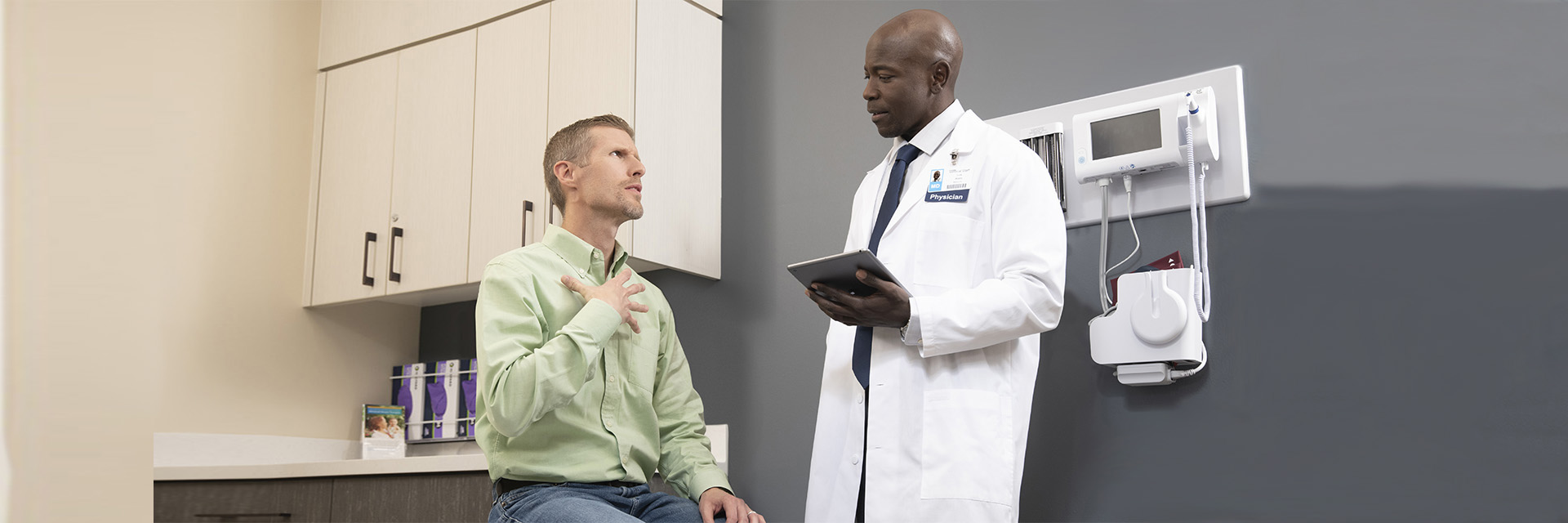A normal heartbeat provides for a regular contraction of the heart muscle. A contraction happens about once per second at rest and increases with exercise or physical exertion. As a result, a healthy person’s heart usually beats 60 to 100 beats per minute.
With atrial fibrillation, or AFib, an abnormal heartbeat (arrhythmia) occurs. The arrhythmia makes the heart’s two upper chambers (atria) contract irregularly and much faster than they should, usually more than 400 beats per minute. The upper chambers then get out of sync with the two lower chambers of the heart (ventricles), leading to blood clots, stroke, heart failure or other heart-related complications.
What Happens During Atrial Fibrillation?
Every heartbeat is controlled by the heart’s electrical system. A normal heartbeat begins with one electrical impulse in the heart’s upper right chamber that creates a sinus rhythm.
Chhabra notes that the pooling of blood in the heart’s ventricles due to AFib increases the risk of blood clots. These blood clots in the heart can travel into the bloodstream and on to the brain, leading to a stroke. AFib accounts for about 1 in 7 strokes. Because the heart can’t pump as well as it should, the risk of heart failure also exists with atrial fibrillation.
Symptoms of AFib

Sometimes AFib causes no symptoms, so you may not know you have it. When there are symptoms, the American Heart Association says you may experience one or more of the following:
- Quivering or fluttering/irregular heartbeat (the most common symptom)
- General fatigue and lack of energy
- Dizziness or feeling lightheaded
- Shortness of breath
- Fainting (syncope)
- Weakness
- Sweating
- Chest pain, pressure or discomfort (this is a medical emergency)
AFib is usually not life-threatening, but its complications can be. “For this reason, atrial fibrillation needs to be treated whether or not you are having any symptoms,” Chhabra says.
Three Types of Atrial Fibrillation
Paroxysmal: Paroxysmal AFib comes and goes on its own. It may last for seconds, minutes, hours or several days before the heart returns to its normal rhythm. People with this type of AFib may experience more symptoms than people with other types as the heart goes in and out of normal rhythm.
Persistent: When the atrial fibrillation does not stop by itself and lasts for more than 7 days, it is considered persistent. Medications or a special type of electrical shock (called cardioversion) are needed to help restore a normal heart rhythm. If no treatment is given, the heart will stay in AFib. If the persistent AFib lasts for more than a year, it is considered long-standing persistent atrial fibrillation.
Permanent: Permanent AFib happens when a normal heart rhythm cannot be restored by medications, procedures and/or controlled electrical shocks.
Risk Factors for the Disease
Even some people who live a healthy lifestyle and don’t have other medical issues develop AFib. However, the Heart Rhythm Society has identified these common causes and risk factors for the disease:
- Age older than 60 years
- Heart problems, such as high blood pressure (hypertension), coronary artery disease, prior heart attacks or heart valve problems
- Diabetes
- Thyroid disease
- Chronic lung disease or blood clots in the lungs
- Sleep apnea
- Excessive alcohol or stimulant use
- Serious illness or infection
Managing AFib
There are treatment options for AFib that you and your doctor should weigh based on several factors. An important step in managing atrial fibrillation is assessing stroke risk, according to Chhabra. “For people with multiple risk factors, such as being over age 65 and having high blood pressure, anticoagulation medications can be recommended to thin the blood to help prevent blood clots and lower the risk of stroke,” he says.
It’s also important to slow your resting heart rate down to a normal range. This can be accomplished with rate control medications such as beta-blockers or calcium channel blockers.
Another goal in treatment is to decide whether to control heart rhythm. Unlike heart rate control, a rhythm control strategy focuses on the pattern of your heartbeats. “The goal is to return your heart to a normal rhythm using antiarrhythmic medication or a non-surgical procedure such as ablation,” Chhabra adds.
While stroke prevention remains the primary treatment goal for AFib, lifestyle modifications that help reduce the risk of getting other heart conditions that are associated with atrial fibrillation are also key.
“Changing your diet and staying active to manage your weight can make your heart healthier, which is good for your overall health,” Chhabra says.
Learn more about your heart health and take our five-minute heart health assessment at TexasHealth.org/Heart.

